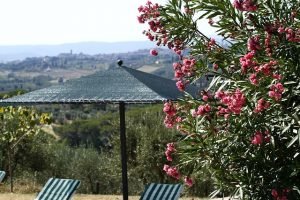Continuing my series of articles for 2019, Materials For A Purpose, I am going to be discussing how best to choose the right materials for your desired purpose and how they best fit into the design of a space. I want to get you thinking about the options you have and how the right selection can give you a cohesive, timeless solution rather than a predictable, uninspiring result.
This month I want to investigate products used for providing shade in the garden.
 Pergolas are a great way to create shade in the garden. There is no doubt that temperatures are changing and we need to protect ourselves from the sun. Pergolas come in all shapes and sizes but are essentially a structure of timber or metal that you sit under. The structure is then a frame for growing plants. I use them in my designs as shade in outdoor entertaining areas. The key is to match the style of structure to the property. We recently built a lovely green oak, chunky pergola to match the old cottage aesthetic where a metal contemporary structure would have been too modern. Pergolas can be free standing or attached to the brick work of your property. They also add interest with height and opportunity for climbing plants to thrive such as Wisteria, roses and grape vines, but beware the fruit from grape vines can stain your patio below.
Pergolas are a great way to create shade in the garden. There is no doubt that temperatures are changing and we need to protect ourselves from the sun. Pergolas come in all shapes and sizes but are essentially a structure of timber or metal that you sit under. The structure is then a frame for growing plants. I use them in my designs as shade in outdoor entertaining areas. The key is to match the style of structure to the property. We recently built a lovely green oak, chunky pergola to match the old cottage aesthetic where a metal contemporary structure would have been too modern. Pergolas can be free standing or attached to the brick work of your property. They also add interest with height and opportunity for climbing plants to thrive such as Wisteria, roses and grape vines, but beware the fruit from grape vines can stain your patio below.
Arbour seats are less imposing as a garden feature but can offer smaller spots of shade for the garden. I like to use arbour seats as a focal point in my designs. A feature at the end of a path helps to draw the eye through a space. An arbour seat is simply a seat with sides and a roof over the top and again is a good frame to grow plants onto. The garden centres up and down the land are full of arbour seat choices but if you are remotely practical they are easy to build from scratch too. Storage space under the seat is very welcome in smaller gardens. It is a good way to encourage children out into the garden and can become a reading space. If you have an existing mature tree, tree seats provide a shady resting spot.
Sails & retractable blinds have become more popular as shade solutions. Again it is down to context and matching the theme of the outdoor space you want to create. Sails can look great in a seaside themed garden with pebbles, chunky natural rope and seaside planting. Sails are obviously nautical and link well with decking and timber structures, but bear in mind that they will only provide limited shade and are much more of a statement feature in a garden as they are harder to soften with planting. Retractable blinds can be useful off the back of a house to give protection from the sun, but beware the cheap and cheerful options as they can look very municipal. I have found over the years of designing gardens that the simple solutions are usually the best. On a pergola we designed and built one year, a simple strained metal wire allowed us to install a material shade that could be drawn across the roof like a curtain when the sun was too hot. When not in use it concertinaed up neatly and looked good.
Planting a tree is a pleasing way to resolve shade issues. Not only are you providing a solution to your problem but you are helping the environment too. As always it is about choosing the right plant for the right place. I like to use trees that will provide a dappled shade into the garden such as Betula utilis Jacquemontii or Amelanchier lamarckii. Trees are becoming very important in our increasingly small spaces for screening unsightly views and it may be that a full grown tree is not appropriate but multi stemmed versions of the above two are readily available and will not dominate the garden. If space allows then a grander gesture may be appropriate and there are too many choices to mention, but why not choose something different such as a copper beech or a candy floss tree!














